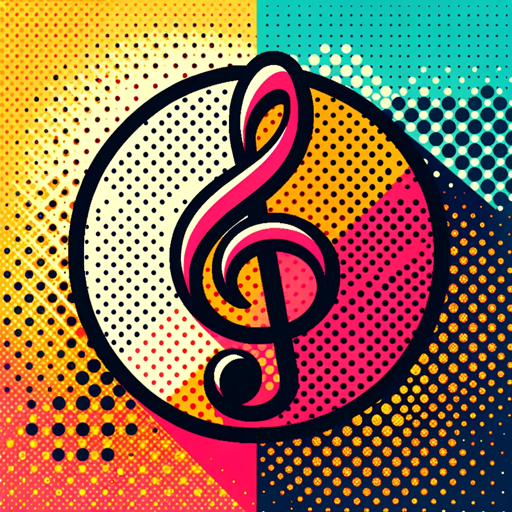Music Theory-music theory analysis tool
AI-powered music theory insights
Start your Journey with Music Theory 101: Scales.
How do Chords work in Jazz vs. Pop Music?
Generate Unique Chords in Midi with Chord Creator.
Can you transcribe this audio into sheet music?
Related Tools
Load More
Music Nerd
Enthusiastic and knowledgeable music history expert.

Music Guide
Music theory and composition guide.

Musica AI
Engaging and versatile composer, skilled in various styles and eras. Ask me to create your next masterpiece.
Music Score
Generates music scores from video audio

音楽理論GPT
音楽理論の質問に答え、作曲をサポートするAI

Classical Music Analysis
A guide for analyzing classical music.
20.0 / 5 (200 votes)
Introduction to Music Theory
Music Theory is the study of the practices and possibilities of music. It involves analyzing the fundamental elements of music such as rhythm, harmony, melody, structure, form, and texture. Music theory can be used to understand and appreciate music on a deeper level, as well as to compose and perform music more effectively. For example, understanding scales and chords helps musicians create harmonious melodies and accompaniments. Knowledge of rhythmic patterns can aid in developing compelling rhythms for different musical genres.

Main Functions of Music Theory
Composition and Arrangement
Example
Creating chord progressions and harmonizing melodies
Scenario
A composer uses knowledge of chord structures and progressions to write a song for a new musical.
Performance Analysis
Example
Analyzing the structure and elements of a musical piece
Scenario
A pianist studies the form and harmonic progression of a classical piece to perform it more expressively.
Educational Tool
Example
Teaching music theory concepts to students
Scenario
A music teacher uses theory exercises to help students understand scales, intervals, and chords.
Ideal Users of Music Theory Services
Composers and Songwriters
These individuals benefit from music theory by gaining the tools to create more structured and harmonious compositions. Understanding the rules and breaking them creatively allows for innovative songwriting.
Music Students and Educators
Students learning instruments or music in general, and educators teaching these subjects, find music theory essential for building a strong foundation in understanding and performing music.

Using Music Theory: A Step-by-Step Guide
Step 1
Visit aichatonline.org for a free trial without login, also no need for ChatGPT Plus.
Step 2
Familiarize yourself with the interface and available tools. Review tutorials or guides available on the site to understand basic and advanced functionalities.
Step 3
Identify your specific use case such as composing music, analyzing compositions, or learning theory. Utilize the search function to find relevant resources and examples.
Step 4
Apply the tools to your music project. For example, use the composition tools to create chord progressions or analyze a piece to understand its theoretical structure.
Step 5
Save your work and export any necessary files. Take advantage of community forums and support to troubleshoot any issues or gain further insights.
Try other advanced and practical GPTs
Graph Theory
AI-powered Graph Theory Analysis and Visualization

Romance Novel Crafter
Craft captivating romance with AI

git hivemind
AI-powered Git management made easy

GlucoseTracker
AI-powered tool for glucose stability

Steamy Stories Generator
AI-Powered Personalized Narrative Creator

STAGE AI
AI-driven platform for creators and designers

Theory of Computation
AI-powered computational theory assistant.

Algebraic Number Theory GPT
AI-powered tool for algebraic number theory solutions.

Game Theory
AI-powered tool for strategic analysis.

DnD Magic Item Generator
AI-powered Magic Item Generator for D&D

Meeting Summary and Action Item Specialist
AI-powered tool for summarizing meetings and identifying action items.

Expand Text
Expand Your Ideas with AI-Powered Precision.

- Research
- Learning
- Teaching
- Composing
- Analyzing
Music Theory Q&A
What is Music Theory AI?
Music Theory AI is an advanced tool designed to help musicians and students understand and apply music theory concepts. It provides resources for analyzing compositions, creating chord progressions, and learning theoretical principles.
How can I start using Music Theory AI?
You can start using Music Theory AI by visiting aichatonline.org for a free trial. No login or ChatGPT Plus subscription is required. The platform offers a user-friendly interface with various tutorials to help you get started.
What types of music can I analyze with Music Theory AI?
Music Theory AI can analyze a wide range of musical genres, including classical, jazz, pop, and more. It helps break down the compositions into their theoretical components, providing detailed insights.
Can Music Theory AI help with composing music?
Yes, Music Theory AI offers tools for composing music. You can create chord progressions, melodies, and harmonies. The platform also provides suggestions based on music theory principles to enhance your compositions.
Is Music Theory AI suitable for beginners?
Absolutely. Music Theory AI is designed to be accessible for users of all levels, from beginners to advanced musicians. It offers comprehensive guides, tutorials, and support to help beginners learn and apply music theory effectively.